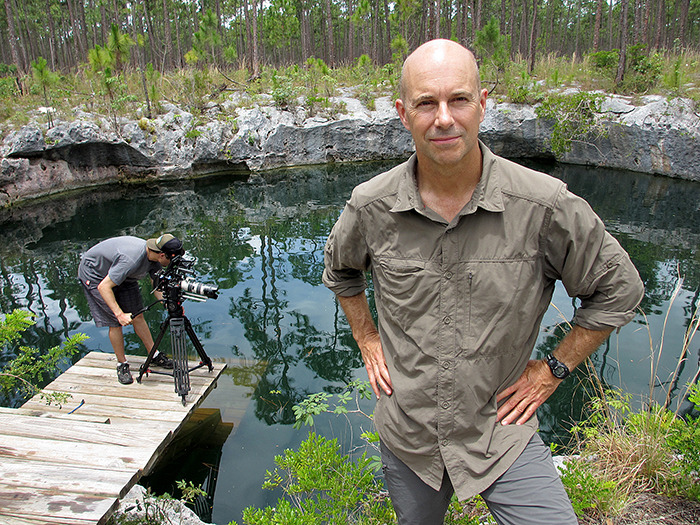Parallax Films continues its commitment to debating and developing 3D talent, technology and dialogue. This week Sean White shares his thoughts about developments in 3D camera technology.
Sean F. White is a Camera Operator/DOP for countless international documentary projects. He is a trained stereographer and has shot and delivered 3D content for Blowdown 3D and Battle Castle.
On this trip to NAB, I was primarily focused on researching 3D camera systems for television documentary acquisition. While there has been some progress in 3D technology since last year, a huge void remains for production companies who seek professional results but don’t have feature film or sports broadcaster budgets.
I’m looking for an integrated twin lens camera system we can take into the field.
Here’s what I found:

Sean White with the Cameron PACE Rig at NAB2012
This is their latest integrated twin camera system. Although it’s predecessor the AG-3DA1 was a great leap for 3D, the camera failed in one big department – the interaxial is too wide for filming subjects and converging on them closer than 15 feet away. Try to converge any closer and your background explodes beyond TV specs of 2-3%. Faraway subjects are fine for sports, talk shows, or cooking shows where subject and convergence are at a distance from the camera but not practical for run and gun doc or serious travel/location shooting.
I hoped their latest model, the AG-3DP1 would correct this, it didn’t. Although the sensors and interface have improvements, the IA was still 58mm. Despite whatever specs sheets may claim, there’s NO WAY you can frame a person (i.e.: a TV host) from the waist up, converge on them, and keep you background within a 2-3% disparity.
While at NAB, I conducted a test with the camera and found that on the widest lens, with convergence set to minimal distance, I’d have to frame an average-height person from the shins up (about 15 feet away) to keep a comfortable 3D. That’s total deal breaker for me since I could never use this camera on any of our hosted programs. Can you imagine never being within 15 feet of your nearest subject? Maybe with the use of third party lens adapters you could make this work, but for now this camera still isn’t a viable option.
Much like the Panasonic, the Sony is an integrated twin lens 3D camera with all the pros of being self-contained, portable, etc. however the inter-axial is smaller (45mm) so you can get closer to your subjects.
I conducted the same test above and found that at the widest angle and converged at the nearest point, I could comfortable frame a person from the waist up and keep background within acceptable 2-3% specs. Not bad.
I also really liked the 3-way control dial for focus, iris, and convergence. This is a nice design feature that speeds up shooting in general with the bonus of allowing dynamic convergence for moving subjects. It’s small enough to fit on our Steadicam Flyer unit but still big enough to shoot smooth and steady off the shoulder.
Although the internal recording specs are pretty good, I’d probably still plan to tap both left and right HDSDI channels and record higher bitrate to our Convergent Design Nano 3D drives.
I definitely would consider this camera for an A-cam hosted doc. We’d still tote around a HDSLR side-by-side system for vista shots but this camera could do 75-90% of the work.
This is the best prosumer camera out there. It could be a great B-roll or POV cam for hard-to-get-at spaces. I played a lot with this camera and was impressed. There is a very nice interface and allows convergence closer than 10 feet. Sweet. We can’t tap both left and right signals to our Nano drives but that’s ok for our purposes. It would also be great for web video blogs. It’s a must have!
This is another integrated twin camera system. I chatted with the developers and the camera is based on a great concept are geared for sports and outdoor rugged applications (industry, military, etc.) But is still in the R&D stage so they’re still have a ways to go before it’s production ready. Additionally, sourcing quality lenses for 2/3 in sensors that can resolve 2K or 4K quality might be a challenge. So this is not an option yet but perhaps down the road… I’ll keep an eye on this one.
GoPro has released a firmware update for their HERO 1 and HERO 2 cams to allow users to keep or remove the colour settings applied to the footage during capture. This means that pro users can now start with more neutral, wider latitude source file. (Consumers who want to take the clips and upload to YouTube won’t want to bother with this.)
So for us, what we’ll experiment with next is using 2 x HERO 2 cameras with the 3D kit AND the new firmware to get the best possible 3D capture. More on this later…
Other than the above, I didn’t find any other self-contained, ready-to-go integrated twin camera systems. Everything else 3D were rigs configured with various components of which there are a multitude of rig / sensor / lens / controller / recorder / monitor / etc. options to consider, but the price adds up!
I also looked into the rigs at 3ality and Pace. Very cool stuff but not practical for our work. Personally, I’m a fan of the StereoTec rigs – designed and engineered by my 3D mentor Florian Maier. If you have budget for a feature, I’d call them first. They’ve got all the auto-aligning technology of 3ality and more. Very solid gear and great people too.
TO BE CONTINUED…
Sean F. White

